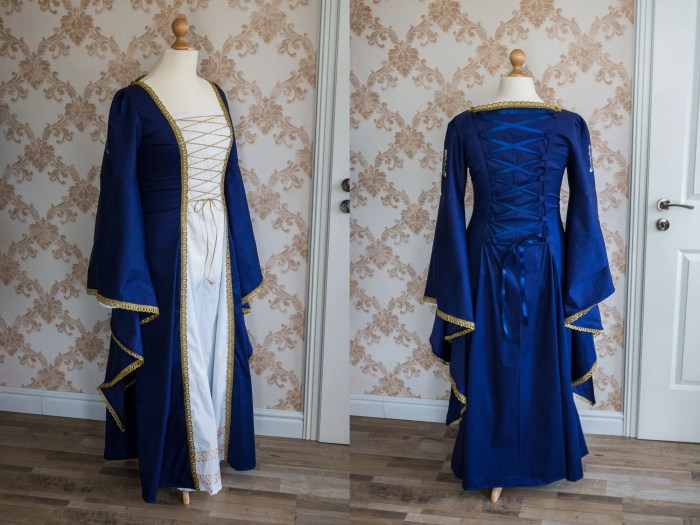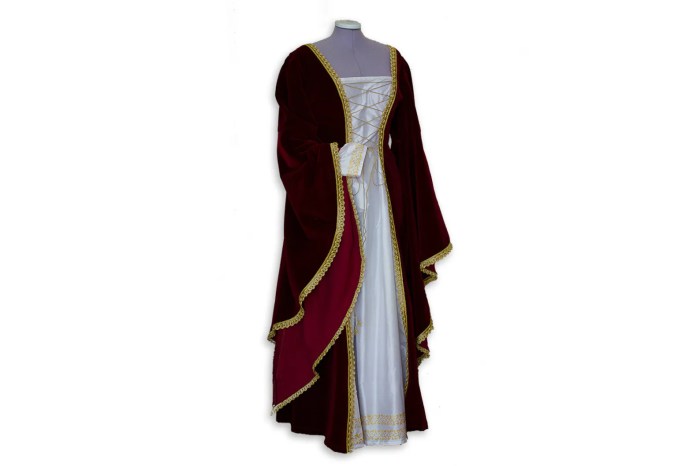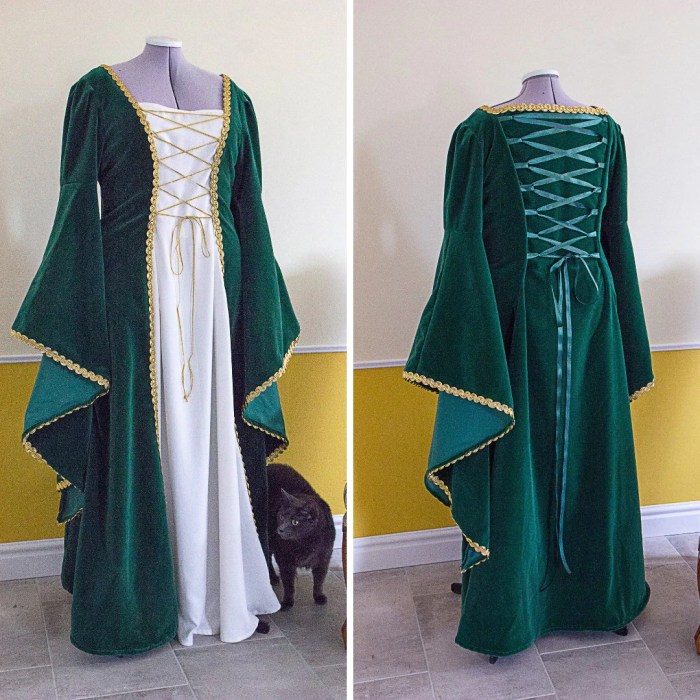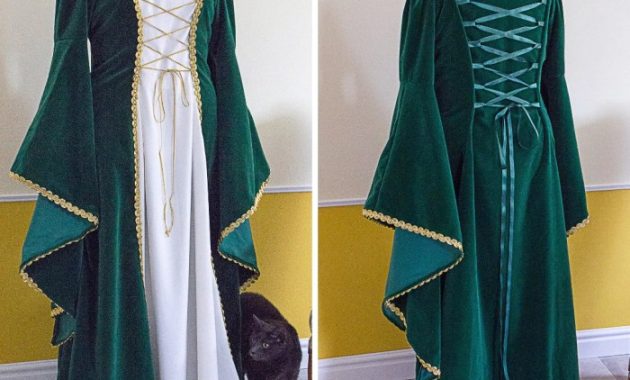Celtic Medieval Wedding Dresses: A Journey Through Time
Celtic medieval wedding dresses – Medieval Celtic wedding attire offers a fascinating glimpse into the social structures, artistic sensibilities, and daily life of the Celtic people. This exploration delves into the historical context, key features, and enduring legacy of these remarkable garments, revealing the rich tapestry of cultural influences and craftsmanship that shaped them.
Historical Context of Celtic Medieval Dress
Celtic medieval wedding attire reflected the complex social hierarchy of the time. Elaborate garments, often featuring rich fabrics and intricate embellishments, signified wealth and status, distinguishing the nobility from the peasantry. The influence of Celtic culture extended beyond its geographical boundaries, impacting medieval European clothing styles with its distinctive patterns, motifs, and techniques. Common materials included wool, linen, and, for the elite, silk.
Regional variations existed, with styles differing based on geographical location and specific tribal traditions. For instance, the styles of the Irish Celts might differ from those of the Scottish or Welsh Celts.
Key Features of Celtic Medieval Wedding Dresses
Celtic medieval wedding dresses possessed several characteristic features. These included various necklines, from high and closed to low and open; sleeves that ranged from long and flowing to short and puffed; and a variety of embellishments, including intricate knotwork, spirals, and animal motifs. These decorative elements held symbolic meaning, often representing fertility, prosperity, or protection. Compared to other European medieval wedding dresses, Celtic garments often displayed a more vibrant use of color and a greater emphasis on intricate textile designs.
| Century | Neckline | Sleeves | Embellishments |
|---|---|---|---|
| 11th | High, round | Long, flowing | Simple brooches, woven patterns |
| 12th | Square, slightly low | Long, fitted | More elaborate knotwork, braid |
| 13th | V-neck, surplice | Elbow-length, slightly puffed | Animal motifs, intricate embroidery |
| 14th | Low, sweetheart | Long, bell-shaped | Metal embellishments, rich colored fabrics |
Colors and Fabrics in Celtic Medieval Wedding Attire

Source: etsystatic.com
Color choices in Celtic medieval wedding dresses held significant meaning. Deep reds symbolized passion and fertility, while blues represented loyalty and protection. Natural dyes, derived from plants and minerals, were commonly used. Woad produced blues, madder yielded reds, and weld created yellows. These dyes were often imbued with symbolic meaning, adding another layer of significance to the attire.
- Wool: Warm, durable, readily available.
- Linen: Cool, comfortable, relatively easy to produce.
- Silk: Luxurious, rare, associated with wealth and status.
Accessories and Headwear

Source: etsystatic.com
Celtic medieval wedding dresses were often complemented by a range of accessories and headwear. These included intricate jewelry, such as brooches, torcs (neck rings), and arm rings, often crafted from precious metals and adorned with gemstones or enamel. Veils and headdresses played a significant role in Celtic wedding traditions, symbolizing purity, modesty, or marital status. A common headdress might be a circlet of woven flowers or a more elaborate jeweled crown for women of higher status.
- Brooches: Often featuring Celtic knotwork or animal motifs, secured garments and held symbolic meaning.
- Torcs: Neck rings, signifying status and wealth, often made of gold or bronze.
- Veils: Symbolized modesty and purity, often made of fine linen or silk.
A visual representation of a Celtic bride’s attire might depict a long, flowing gown of deep red wool, adorned with intricate Celtic knotwork embroidery. A jeweled torc would encircle her neck, and a delicate veil would cascade over her shoulders. Her hair might be adorned with a circlet of woven flowers, completing a look of both elegance and symbolic richness.
Celtic medieval wedding dresses often featured rich fabrics and intricate embroidery, reflecting the craftsmanship of the era. While vastly different in style and period, the opulence of these gowns is comparable to the breathtaking design of Blake Lively’s Marchesa wedding dress, as seen in detail here: blake lively wedding dress marchesa. Both exemplify a commitment to exquisite detail and showcase the enduring appeal of beautiful bridal attire, though separated by centuries of fashion evolution.
Modern Interpretations of Celtic Medieval Wedding Dresses

Source: etsystatic.com
Modern interpretations of Celtic medieval wedding dresses retain the essence of the historical styles while adapting them to contemporary tastes and materials. Modern designers incorporate Celtic elements, such as knotwork patterns, spiral motifs, and rich color palettes, into contemporary wedding gowns. These designs might feature flowing silhouettes, intricate lacework, and luxurious fabrics like silk or satin, creating a blend of historical inspiration and modern elegance.
While traditional designs relied on hand-spun and hand-woven fabrics and laborious construction techniques, modern designs often utilize machine-made fabrics and more efficient construction methods.
Q&A
What were common fabrics besides wool and linen used in Celtic medieval wedding dresses?
Silk, when available, was a luxurious choice, along with possibly hemp or even finer materials like velvet depending on the bride’s social standing and regional availability.
How did the social status of the bride affect her wedding dress?
Higher-status brides would have worn richer fabrics, more elaborate embellishments, and potentially more complex designs compared to those of lower social standing.
Were there regional differences in Celtic wedding dress styles across different parts of Europe?
Yes, significant regional variations existed. The specific styles, materials, and embellishments used would vary based on local traditions and available resources.
What is the significance of specific colors in Celtic medieval wedding attire?
Color symbolism varied, but certain colors, like deep reds and blues, might have signified wealth or status. Natural dyes would have limited the available color palette.

